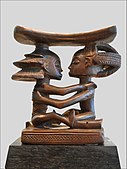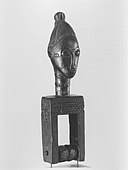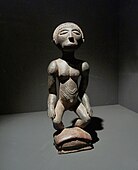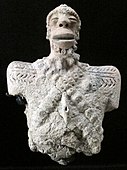African art
| History of art |
|---|
African art describes modern and historical paintings, sculptures, installations, and other visual cultures from native or indigenous Africans and the African continent. The definition may also include the art of the African diasporas, such as art in African-American, Caribbean or South American societies inspired by African traditions. Despite this diversity, there are unifying artistic themes present when considering the totality of the visual culture from the continent of Africa.[2]
Pottery, metalwork, sculpture, architecture, textile art, and fiber art are important visual art forms across Africa and may be included in the study of African art. The term "African Art" does not usually include the art of the North African areas along the Mediterranean coast, as such areas had long been part of different traditions. For more than a millennium, the art of such areas had formed part of Berber or Islamic art, however, with many particular local characteristics.
Ethiopian art, with a longstanding Christian tradition,[3] is also different from that of most African art, where Traditional African religion (with Islam prevalent in the north) was dominant until the 20th century.[4] African art includes prehistoric and ancient art, the Islamic art of West Africa, the Christian art of East Africa, and the traditional artifacts of these, and other regions. Many African sculptures were historically made of wood and other natural materials that have not survived from earlier than a few centuries ago, although rare older pottery and metal figures can be found in some areas.[5] Some of the earliest decorative objects, such as shell beads and evidence of paint, have been discovered in Africa, dating to the Middle Stone Age.[6][7][8] Masks are important elements in the art of many people, along with human figures, and are often highly stylised. There is a wide variety of styles, often varying within the same context of origin and depending on the use of the object, but wide regional trends are apparent. Sculpture is most common among "groups of settled cultivators in the areas drained by the Niger and Congo rivers" in West Africa.[9] Direct images of deities are relatively infrequent, but masks in particular are or were often made for ritual ceremonies. Since the late 19th century, there has been an increasing amount of African art in Western collections, the finest pieces of which are displayed as part of the history of colonization.
African art had an important influence on European Modernist art,[10] which was inspired by their interest in abstract depiction. It was this appreciation of African sculpture that has been attributed to the very concept of "African art", as seen by European and American artists and art historians.[11]
West African cultures developed bronze casting for reliefs, like the famous Benin Bronzes, to decorate palaces and for highly naturalistic royal heads from around the Bini town of Benin City, Edo State, as well as in terracotta or metal, from the 12th–14th centuries. Akan gold weights are a form of small metal sculptures produced from 1400–1900; some represent proverbs, contributing a narrative element rare in African sculpture; and royal regalia included gold sculptured elements.[12] Many West African figures are used in religious rituals and are often coated with materials placed on them for ceremonial offerings. The Mande-speaking peoples of the same region make pieces from wood with broad, flat surfaces and arms and legs shaped like cylinders. In Central Africa, however, the main distinguishing characteristics include heart-shaped faces that are curved inward and display patterns of circles and dots.
Thematic elements
[edit]- In Western African art, there is a focus on being expressive and unique while still being influenced by the art of those who came before. The art of the Dan people is an example of this, and it has also spread to Western African communities outside of the continent.[13]
- Emphasis on the human figure: The human figure has always been the primary subject matter for most African art, and this emphasis even influenced certain European traditions.[10] For example, in the fifteenth century, Portugal traded with the Sapi culture near the Ivory Coast in West Africa, who created elaborate ivory salt cellars that were hybrids of African and European designs, most notably in the addition of the human figure (the human figure typically did not appear in Portuguese saltcellars). The human figure may symbolize the living or the dead, reference chiefs, dancers, or various trades or even be an anthropomorphic representation of a god or have other votive functions. Another common theme is the intermorphosis of humans and animals.
- Visual abstraction: African artworks tend to favour visual abstraction over naturalistic representation. This is because many African artworks generalize stylistic norms.[14]
Scope
[edit]The study of African art until recently focused on the traditional art of certain well-known groups on the continent, with a particular emphasis on traditional sculpture, masks and other visual culture from non-Islamic West Africa, Central Africa,[15] and Southern Africa with a particular emphasis on the 19th and 20th centuries. Recently, however, there has been a movement among African art historians and other scholars to include the visual culture of other regions and time periods. The notion is that by including all African cultures and their visual culture over time in African art, there will be a greater understanding of the continent's visual aesthetics across time. Finally, the arts of the African diaspora, in Brazil, the Caribbean and the south-eastern United States, have also begun to be included in the study of African art.
Materials
[edit]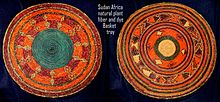
African art is produced using a wide range of materials and takes many distinct shapes. Because wood is a prevalent material, wood sculptures make up the majority of African art. Other materials used in creating African art include clay soil. Jewelry is a popular art form used to indicate rank, affiliation with a group, or purely aesthetics.[16] African jewelry is made from such diverse materials as Tiger's eye stone, Hematite, Sisal, coconut shell, beads and Ebony wood. Sculptures can be wooden, ceramic or carved out of stone like the famous Shona sculptures,[17] and decorated or sculpted pottery comes from many regions. Various forms of textiles are made including Kitenge, mud cloth and Kente cloth. Mosaics made of butterfly wings or colored sand are popular in West Africa. Early African sculptures can be identified as being made of terracotta and bronze.[18]
Black Art Institutions and Recognition
[edit]The increasing recognition of Black American art has led to the establishment of institutions dedicated to preserving and showcasing this legacy. The Smithsonian National Museum of African American History and Culture in Washington, D.C., and The Studio Museum in Harlem are just two examples of spaces where Black art is celebrated. Additionally, major museums and galleries across the country are increasingly featuring exhibitions that highlight the contributions of Black artists.
Traditional African religions
[edit]Traditional African religions have significantly shaped the art forms and cultural expressions across the African continent. These religions often emphasize the connection between the spiritual and material worlds, resulting in art that serves a functional and symbolic role.
Artworks created within these traditions frequently embody religious symbolism, utilitarianism, and functionality. For instance, masks, sculptures, and figurines are often integral to rituals, ceremonies, and spiritual practices, symbolizing ancestral spirits, deities, or cosmic forces.[19]
One central theme is the veneration of ancestors, who are viewed as intermediaries between the living and the divine. Ancestor worship inspires the creation of ritualistic objects, such as carved statues, ceremonial masks, and sacred relics, used to honor and communicate with these spiritual entities. For example, the Baule and Dogon peoples produce highly detailed figurines and masks for rituals aimed at ensuring communal well-being.[20]
Traditional African art also serves as a means of depicting deities and natural forces. Gods such as Ogun, the deity of iron, war, and craftsmanship in Yoruba religion, are often represented through sculptures or tools imbued with symbolic power.[21]
The influence of external religions, particularly Christianity and Islam, has also left a lasting imprint on African art. Over centuries, elements of these faiths have been integrated into traditional religious practices, resulting in syncretic artworks that blend indigenous and foreign iconography. For example, Islamic geometric patterns have influenced West African textiles, while Christian symbolism appears in the Ethiopian Orthodox Church’s illuminated manuscripts and murals.[22][23]
Art in traditional African religions remains a living expression of cultural heritage, spiritual beliefs, and societal values, continuing to evolve alongside contemporary influences.
History
[edit]The origins of African art lie long before the recorded history. The region's oldest known beads were made from Nassarius shells and worn as personal ornaments 72,000 years ago.[6] In Africa, evidence for the making of paints by a complex process exists from about 100,000 years ago[7] and of the use of pigments from around 320,000 years ago.[8][24] African rock art in the Sahara in Niger preserves 6000-year-old carvings.[25] Along with sub-Saharan Africa, the Western cultural arts, ancient Egyptian paintings and artifacts, and indigenous southern crafts also contributed greatly to African art. The abundance of surrounding nature was often depicted through abstract interpretations of animals, plant life, or natural designs and shapes. The Nubian Kingdom of Kush in modern Sudan was in close and often hostile contact with Egypt and produced monumental sculptures mostly derivative of styles that did not lead to the north. In West Africa, the earliest known sculptures are from the Nok culture, which thrived between 1,500 BC and 500 AD in modern Nigeria. Its clay figures typically feature elongated bodies and angular shapes.[26]
More complex methods of producing art were developed in sub-Saharan Africa around the 10th century, some of the most notable advancements include the bronze work of Igbo Ukwu and the terracotta and metalworks of Ile Ife Bronze and brass castings, often ornamented with ivory and precious stones, became highly prestigious in much of West Africa, sometimes being limited to the work of court artisans and identified with royalty, as with the Benin Bronzes.
As Europeans explored the coasts of West Africa, they discovered a wide range of functional objects that Africans used for cultural, social, and economic purposes. Oath devices, for instance, were essential to securing business relationships during the era of the Atlantic slave trade. Though these works of craftsmanship followed their own aesthetic principles, they were regarded as tools of sorcery by European travel writers and reduced to a category of "fetish," which was understood to be outside the realm of art.[27]
Influence on Western art
[edit]
During and after the 19th and 20th-century colonial period, Westerners long characterized African art as "primitive." The term carries with it negative connotations of underdevelopment and poverty. Colonization during the nineteenth century set up a Western understanding hinged on the belief that African art lacked technical ability due to its low socioeconomic status.
At the start of the twentieth century, art historians like Carl Einstein, Michał Sobeski and Leo Frobenius published important works about the theme, giving African art the status of an aesthetic object, not only of an ethnographic object.[28] At the same time, artists like Paul Gauguin, Pablo Picasso, Georges Braque, André Derain, Henri Matisse, Joseph Csaky, and Amedeo Modigliani became aware of and inspired by, African art, amongst other art forms.[10] In a situation where the established avant-garde was straining against the constraints imposed by serving the world of appearances, African art demonstrated the power of supremely well-organized forms; produced not only by responding to the faculty of sight but also and often primarily, the faculty of imagination, emotion and mystical and religious experience. These artists saw in African art a formal perfection and sophistication unified with phenomenal expressive power. The study of and response to African art, by artists at the beginning of the twentieth century facilitated an explosion of interest in the abstraction, organization, and reorganization of forms, and the exploration of emotional and psychological areas hitherto unseen in Western art. By these means, the status of visual art was changed. Art ceased to be merely and primarily aesthetic, but became also a true medium for philosophic and intellectual discourse, and hence more truly and profoundly aesthetic than ever before.[29]
- Abstraction and Form: African sculptures and masks showcased a departure from literal representation, emphasizing geometric forms and symbolic proportions, which inspired movements like Cubism and Fauvism.
- Emotional and Psychological Depth: The expressive power of African art encouraged modernist artists to explore raw emotion, spirituality, and the subconscious.
- Philosophical and Intellectual Discourse: The integration of African aesthetics transformed art from mere representation to a medium for exploring profound ideas, redefining the role of visual art in intellectual and cultural contexts.
Traditional art
[edit]Traditional art describes the most popular and studied forms of African art typically found in museum collections.
Wooden masks, which might either be of human, animal or legendary creatures, are one of the most commonly found forms of art in Western Africa. In their original contexts, ceremonial masks are used for celebrations, initiations, crop harvesting, and war preparation. The masks are worn by a chosen or initiated dancer. During the mask ceremony the dancer goes into a deep trance, and during this state of mind he "communicates" with his ancestors. The masks can be worn in three different ways: vertically covering the face: as helmets, encasing the entire head, and as a crest, resting upon the head, which was commonly covered by material as part of the disguise. African masks often represent a spirit and it is strongly believed that the spirit of the ancestors possesses the wearer. Most African masks are made with wood, and can be decorated with: Ivory, animal hair, plant fibers (such as raffia), pigments (like kaolin), stones, and semi-precious gems also are included in the masks.
Statues, usually of wood or ivory, are often inlaid with cowrie shells, metal studs and nails. Decorative clothing is also commonplace and comprises another large part of African art. Among the most complex of African textiles is the colorful, strip-woven Kente cloth of Ghana. Boldly patterned mudcloth is another well-known technique.
Black American Art: A Legacy Found in America
[edit]Black American art holds a significant place in the cultural tapestry of the United States, serving as a testament to the resilience, creativity, and depth of the Black experience. This artistic heritage spans centuries, encompassing various mediums, movements, and messages that reflect the complex history and evolving identity of African Americans. From the earliest expressions in enslaved communities to contemporary works celebrated in galleries and museums, Black American art continues to shape and redefine the cultural narrative of America.
The Harlem Renaissance: A Cultural Awakening
[edit]The Harlem Renaissance of the 1920s and 1930s marked a pivotal moment in Black American art. Centered in Harlem, New York, this movement celebrated African American identity, history, and culture. Visual artists like Aaron Douglas, Jacob Lawrence, and Augusta Savage produced works that captured the vibrancy of Black life and the struggles for equality. Their art often drew on themes from African heritage, jazz, and the realities of segregation, creating pieces that were both politically charged and aesthetically innovative.
Augusta Savage, a sculptor, is particularly renowned for her work “The Harp,” created for the 1939 New York World’s Fair. The piece, inspired by the song “Lift Every Voice and Sing,” became a symbol of pride and resilience. Similarly, Jacob Lawrence's "The Migration Series" documented the Great Migration, telling the story of millions of African Americans who moved from the rural South to urban centers in the North in search of better opportunities.
Contemporary Black American Art
[edit]Today, Black American art continues to thrive, breaking boundaries and addressing new challenges. Artists like Kara Walker, Kehinde Wiley, and Amy Sherald have gained international acclaim for their groundbreaking work. Kara Walker’s silhouettes confront the brutal realities of slavery, challenging viewers to grapple with America’s historical legacy. Known for their vibrant portraits, Kehinde Wiley and Amy Sherald gained widespread recognition when they received commissions to paint the official portraits of President Barack Obama and First Lady Michelle Obama, respectively.
These contemporary artists, among many others, engage with themes of identity, power, and representation, creating works that resonate with audiences across the globe.
Black Art Institutions and Recognition
[edit]The increasing recognition of Black American art has led to establishing institutions dedicated to preserving and showcasing this legacy. The Smithsonian National Museum of African American History and Culture in Washington, D.C., and The Studio Museum in Harlem are just two examples of spaces where Black art is celebrated. Additionally, major museums and galleries across the country are increasingly featuring exhibitions highlighting Black artists' contributions.
Contemporary African art
[edit]
Africa is home to a thriving contemporary art and fine art culture. This has been under-studied until recently, due to scholars' and art collectors' emphasis on traditional art. Notable modern artists include El Anatsui, Marlene Dumas, William Kentridge, Karel Nel, Kendell Geers, Yinka Shonibare, Zerihun Yetmgeta, Odhiambo Siangla, Elias Jengo, Olu Oguibe, Lubaina Himid, Bili Bidjocka and Henry Tayali. Art bienniales are held in Dakar, Senegal, and Johannesburg, South Africa. Many contemporary African artists are represented in museum collections, and their art may sell for high prices at art auctions. Despite this, many contemporary African artists tend to have a difficult time finding a market for their work. Many contemporary African arts borrow heavily from traditional predecessors. Ironically, this emphasis on abstraction is seen by Westerners as an imitation of European and American Cubist and totemic artists, such as Pablo Picasso, Amedeo Modigliani and Henri Matisse, who, in the early twentieth century, were heavily influenced by traditional African art. This period was critical to the evolution of Western modernism in visual arts, symbolized by Picasso's breakthrough painting Les Demoiselles d'Avignon.[30]
Today, Fathi Hassan is considered a major early representative of contemporary black African art. Contemporary African art was pioneered in the 1950s and 1960s in South Africa by artists like Irma Stern, Cyril Fradan, and Walter Battiss and through galleries like the Goodman Gallery in Johannesburg. More recently European galleries such as the October Gallery in London and collectors such as Jean Pigozzi,[31] Artur Walther[32] and Gianni Baiocchi in Rome have helped expand the interest in the subject. Numerous exhibitions at the Museum for African Art in New York and the African Pavilion at the 2007 Venice Biennale, which showcased the Sindika Dokolo African
Collection of Contemporary Art has gone a long way to counter many of the myths and prejudices that haunt Contemporary African Art. The appointment of Nigerian Okwui Enwezor as artistic director of Documenta 11 and his African-centred vision of art propelled the careers of countless African artists onto the international stage.
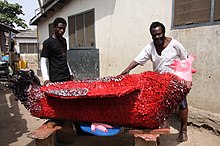
A wide range of more-or-less traditional forms of art or adaptations of traditional style to contemporary taste is made for sale to tourists and others, including so-called "airport art". Several vigorous popular traditions assimilate Western influences into African styles such as the elaborate fantasy coffins of Southern Ghana, made in a variety of different shapes which represent the occupations or interests of the deceased or elevate their status. The Ga believe that an elaborate funeral will benefit the status of their loved ones in the afterlife, so families often spare no expense when deciding which coffin they want for their relatives.[33] These coffins can take the forms of cars, cocoa pods, chickens, or any other shape a family may decide best represents their deceased loved one.[34]
Pop art and advertising art
[edit]Art used to advertise for local businesses, including barbershops, movie houses, and appliance stores has become internationally celebrated in galleries and has launched the careers of many contemporary African artists, from Joseph Bertiers of Kenya to several movie poster painters in Ghana.[35] Ghanaian hand-painted movie posters on canvas and flour sacks from the 1980s and 1990s have been exhibited at museums around the world and sparked viral social media attention due to their highly imaginative and stylized depictions of Western films.[36][37] This creative interpretation of Western culture through African art styles is also on display with the tradition of praise portraits depicting international celebrities, which often served as storefront advertising art, and have since become widely valued and collected in the global art market.
Minimalist African art
[edit]Another notable contemporary African artist is Amir Nour, a Sudanese artist who lived in Chicago. In the 1960s he created a metal sculpture called Grazing at Shendi (1969) which consists of geometric shapes that connect with his memory of his homeland.[38] The sculpture resembles grazing sheep in the distance. He valued discovering art within the society of the artist, including culture, tradition, and background.[39]
By country, civilizations or people
[edit]West Africa
[edit]Ghana
[edit]This section has multiple issues. Please help improve it or discuss these issues on the talk page. (Learn how and when to remove these messages)
|
In the 17th century, the area in West Africa, now known as Ghana, was highly prolific. The states that belonged to Ghana were connected through trading networks and shared cultural beliefs. However, each of them decided to remain politically independent. This was until the early 18th century, when leader Osei Tutu began a vast land expansion that eventually brought together these smaller states, forming a bigger kingdom.
The kingdom’s involvement in gold, cloth, and slave trades was not just significant, but it also generated immense wealth. This economic power upheld a flourishing artistic culture, making the kingdom a hub of cultural and economic activity.
Ghana is most famous for creating the most famous African expressions and works. These works range from wood carvings to brass works, figures, and even gems.

A Kente is a traditional, multi-coloured, hand-woven, quilted cloth. It is also a sort of silk and cotton texture made of interlaced cloth strips. The cloth is central to the Ghanaian culture and it is also traditionally used to be worn as a wrap-around for both men and women with slightly different variations for both of them. This fabric is worn by almost every Ghanaian tribe member.
- Colors And Meaning
There are different color variations for the Kente, each color has different meanings. Here are some examples:
Black: maturation
White: purification
Yellow: preciousness
Blue: peacefulness
Red: bloodshed[40]
Akan art originated among the Akan people. Akan art is known for its vibrant artistic traditions, including textiles, sculptures, Akan gold weights, as well as gold and silver jewelry. The Akan people are known for their strong connection between visual and verbal expressions and a distinctive blending of art and philosophy. Akan culture values gold above all other metals and believes that it can portray the supernatural elements behind many things, including royal authority and cultural values. The Asante, a dominant Akan-speaking culture in Ghana, trace their origins back to the arrival of a golden stool, which is now said to hold the soul of the Asante nation within it. Gold was considered an earthly counterpart to the sun and was often utilized in art to display the importance of the king, making it an essential representation of their cultural and social values.[41] Kente cloth is another extremely important art tradition of Akan culture. Tradition states that Kente cloth originated as weavers tried to copy the weaving abilities of spiders with their webs. Kente cloth is world renowned for its colors and patterns. Its original purpose was to portray royal power and authority, but has now become a symbol of tradition and has been adopted by several other cultures.[42]
-
Ashanti trophy head; circa 1870; pure gold; Wallace Collection (London). This artwork represents an enemy chief killed in battle. Weighing 1.5 kg (3.3 lb), it was attached to the Asante king's state sword
-
Doll (Akuaba); 20th century; 27.3 x 11.4 x 3.8 cm (103⁄4 x 41⁄2 x 11⁄2 in.); Brooklyn Museum (New York City)
-
Soul washer badge (Akrafokonmu); 18th-19th century; gold; Metropolitan Museum of Art (New York City)
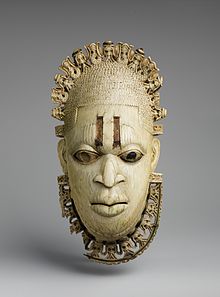

Nigeria
[edit]Nigerian culture is illustrated through art and folklore. Nigeria draws its inspiration for their art from the traditional folk heritage of the region. There are different types of artwork from the Nigerian culture. Some of these works of art can be stone carvings, potteries, glasswork, wood carvings and bronze works. Benin and Awka are considered to be the central places for wood carving. Woodcarvers have been thriving throughout the south of Nigeria from time immemorial.
Examples of Nigerian Traditional Art
Masks
Masks are a piece of the animist confidence of the Yoruba individuals. The veils are painted, and fans wear them at memorial services and different functions to mollify the spirits.
Pottery
Pottery has a long custom in Nigeria. Pottery was well known from 100 B.C. These days Suleja, Abuja and Ilorin are viewed as significant figures of customary ceramics. Potters in Nigeria are frequently female and usually practice for the methods to be passed on through families.
Textiles
Yorubas utilize a bush to make indigo-shaded batik-colored fabric. Ladies generally do the withering, while in the north, the specialty is drilled only by men. Weavers everywhere throughout the nation produce a splendid texture with ribbon structures. Oyo state is known for its fine loom materials while fabric from Abia state utilizes a broadloom strategy.
The Nok culture is an early Iron Age population whose material remains are named after the Ham village of Nok in Kaduna State of Nigeria, where their famous terracotta sculptures were first discovered in 1928. The Nok Culture appeared in northern Nigeria around 1500 BC[26] and vanished under unknown circumstances around 500 AD, thus having lasted approximately 2,000 years.[43]
The function of Nok terracotta sculptures remains unknown. For the most part, the terracotta is preserved in the form of scattered fragments. That is why Nok art is best known today only for the heads, both male and female, whose hairstyles are particularly detailed and refined. The statues are in fragments because the discoveries are usually made from alluvial mud,[44][45][46] in terrain made by the erosion of water. The terracotta statues found there are hidden, rolled, polished, and broken. Rarely are works of great size conserved intact making them highly valued in the international art market. The terracotta figures are hollow, coil-built, nearly life-sized human heads and bodies that are depicted with highly stylized features, abundant jewelry, and varied postures.
Little is known of the original function of the pieces, but theories include ancestor portrayal, grave markers, and charms to prevent crop failure, infertility, and illness. Also, based on the dome-shaped bases found on several figures, they could have been used as finials for the roofs of ancient structures. Margaret Young-Sanchez, Associate Curator of Art of the Americas, Africa, and Oceania in The Cleveland Museum of Art, explains that most Nok ceramics were shaped by hand from coarse-grained clay and subtractively sculpted in a manner that suggests an influence from wood carving. After some drying, the sculptures were covered with slip and burnished to produce a smooth, glossy surface. The figures are hollow, with several openings to facilitate thorough drying and firing. The firing process most likely resembled that used today in Nigeria, in which the pieces are covered with grass, twigs, and leaves and burned for several hours.
As a result of natural erosion and deposition, Nok terracottas were scattered at various depths throughout the Sahel grasslands, causing difficulty in the dating and classification of the mysterious artifacts. Two archaeological sites, Samun Dukiya and Taruga, were found containing Nok art that had remained unmoved. Radiocarbon and thermo-luminescence tests narrowed the sculptures’ age down to between 2,000 and 2,500 years ago, making them some of the oldest in Western Africa. Many further dates were retrieved in the course of new archaeological excavations, extending the beginnings of the Nok tradition even further back in time.[47]
Because of the similarities between the two sites, archaeologist Graham Connah believes that "Nok artwork represents a style that was adopted by a range of iron-using farming societies of varying cultures, rather than being the diagnostic feature of a particular human group as has often been claimed."
-
Nok seated figure; 5th century BC – 5th century AD; terracotta; 38 cm (1 ft 3 in); Musée du quai Branly (Paris). In this Nok work, the head is dramatically larger than the body supporting it, yet the figure possesses elegant details and a powerful focus. The neat protrusion from the chin represents a beard. Necklaces from a cone around the neck and keep the focus on the face.
-
Relief fragment with heads and figures; 5th century BC – 5th century AD; length: 50 cm (20 in), height: 54 cm (21 in), width: 50 cm (20 in); terracotta; Musée du quai Branly. Like most African art styles, the Nok style focuses mainly on people, rarely on animals. All of the Nok statues are stylized and similar in that they have triangular-shaped eyes with perforated pupils, and arched eyebrows.
-
Male head; 550–50 BC; terracotta; Brooklyn Museum (New York City, USA). The mouth of this head is slightly open. It may suggest speech, that the figure has something to say. This is a figure that seems to be in the midst of a conversation. The eyes and the eyebrows suggest an inner calm or an inner serenity.
-
Male figure; terracotta; Detroit Institute of Art (Michigan, USA)
Benin art
[edit]Benin art is the art from the Kingdom of Benin or Edo Empire (1440–1897), a pre-colonial African state located in what is now known as the South-South region of Nigeria. The Benin Bronzes are a group of more than a thousand metal plaques and sculptures that decorated the royal palace of the Kingdom of Benin in what is now modern-day Nigeria.[a] Collectively, the objects form the best-known examples of Benin art, created from the thirteenth century onwards, by the Edo people, which also included other sculptures in brass or bronze, including some famous portrait heads and smaller pieces.
In 1897 most of the plaques and other objects in the collection were taken by a British force during the Benin Expedition of 1897, which took place as British control in Southern Nigeria was being consolidated.[50] Two hundred of the pieces were taken to the British Museum, while the rest were purchased by other museums in Europe.[51] Today, a large number are held by the British Museum,[50] as well as by other notable collections in German and American museums.[52]
-
Plaque with warriors and attendants; 16th–17th century; brass; height: 47.6 cm (183⁄4 in.); Metropolitan Museum of Art (New York City)
-
Plaque equestrian an Oba on horseback with attendants; between 1550 and 1680; brass; height: 49.5 cm (197⁄16 in.), width: 41.9 (161⁄2 in.), diameter: 11.4 cm (41⁄2 in.); Metropolitan Museum of Art
-
Plaque that probably represents a musician; 17th century; bronze; 48.26 cm (19 in.) x 18.42 (71⁄4 in.) x 8.89 cm (31⁄2 in.), irregular; Los Angeles County Museum of Art (USA)
-
Rooster figure; 18th century; brass; overall: 45.4 cm (177⁄8 in.); Metropolitan Museum of Art
-
Bronze Head of Queen Idia; early 16th century; bronze; Ethnological Museum of Berlin (Germany). Four cast bronze heads of the queen are known and are currently in the collections of the British Museum, the World Museum (Liverpool), the Nigerian National Museum (Lagos) and the Ethnological Museum of Berlin.
-
Leopard aquamanile; 17th century; brass; Ethnological Museum of Berlin. The bronze leopards were used to decorate the altar of the oba. The leopard, a symbol of power, appears in many bronze plaques, from the oba's palace.
-
Figure of a horn blower; 1504–1550; copper alloy; 62.2 x 21.6 x 15.2 cm (241⁄2 x 81⁄2 x 6 in.); Brooklyn Museum (New York City). Blowing a horn or flute with his right hand, his left arm is truncated. He also wears a netted cap with chevron design decorated with a feather.
-
Benin ivory mask of the queen mother Idia; 16th century; ivory, iron & copper; Metropolitan Museum of Art. One of four related ivory pendant masks among the prized regalia of the Oba of Benin; taken during the Benin Expedition of 1897 in the Southern Nigeria Protectorate
Igbo
[edit]The Igbo produce a wide variety of art, including traditional figures, masks, artifacts and textiles, plus works in metals such as bronze. Artworks from the Igbo have been found from as early as the 9th century with the bronze artifacts found at Igbo Ukwu. Their masks are similar to the Fang ones, as they share a combination of white and black colors in roughly the same areas.
-
Maiden spirit mask; early 20th century; wood & pigment; Brooklyn Museum (New York City, USA)
-
A mask known as the Queen of Women (Eze Nwanyi); late 19th-early 20th century; wood & pigment; Birmingham Museum of Art (Alabama, USA)
-
Bronze ceremonial vessel in form of a snail shell; 9th century; Igbo-Ukwu; Nigerian National Museum (Lagos, Nigeria)
-
Bronze ornamental staff head; 9th century; Igbo-Ukwu; Nigerian National Museum
-
Female figure for a small temple; 20th century; Indianapolis Museum of Art
Yoruba
[edit]Yoruba art is best known for the heads from Ife, made from ceramic, brass and other materials. Much of their art is associated with the royal courts. They also produced elaborate masks and doors, full of details and painted in bright colors, such as blue, yellow, red and white.
-
Head of a king or dignitary; 12th–15th century AD; terracotta; Ethnological Museum of Berlin (Germany); discovered at Ife (Nigeria)
-
Mask for Obalufon II; circa 1300 AD; copper; height: 29.2 cm; discovered at Ife; Ife Museum of Antiquities (Ife, Nigeria)[53]
-
Gelede mask; circa 1900–1915; Detroit Institute of Arts (USA)
-
Pair of door panels and a lintel; circa 1910–1914; by Olowe of Ise; (British Museum, London)
Other ethnic groups of Nigeria
[edit]-
Carved door; circa 1920–1940; wood with iron staples; by Nupe people; Hood Museum of Art (Hanover, New Hampshire, USA)
-
Headdress; early 1900s; wood, antelope skin, basketry, cane, metal; by Ejagham people; Cleveland Museum of Art (USA)
-
Headdress; early 1900s; wood, hair; Idoma people; Cleveland Museum of Art
-
Otobo (hippopotamus) mask; by Kalabari people; British Museum (London)
Mali
[edit]The primary ethnic groups in Mali are the Bambara (also known as Bamana) and the Dogon. Smaller ethnic groups consist of the Marka, and the Bozo fisherman of the Niger River. Ancient civilizations flourished in areas like Djene and Timbuktu, where a great variety of ancient bronze and terracotta figures have been unearthed.
Djenné-Djenno
[edit]Djenné-Djenno is famous for its figurines which depict humans and animals including snakes and horses. They are made of terracotta, a material that has been used in West Africa for some ten thousand years.
-
Terracotta seated figure; 13th century; earthenware; 29.9 cm (113⁄4 in.) high; Metropolitan Museum of Art (New York City, USA) The raised marks and indentations on the back of this hunched Djenné figure may represent disease or, more likely, sacrification patterns. The facial expression and pose could depict an individual in mourning or pain.
-
Female figure; 13th-–15th century; terracotta covered with red ochre; height: 37.5 cm (14.8 in), width: 31 cm (12 in), depth: 24 cm (9.4 in); Musée du quai Branly (Paris)
-
Equestrian figure; 13th–15th century; height: 70.5 cm; National Museum of African Art (Washington D.C., USA)
-
Male figure; 14th-17th century; Cleveland Museum of Art (Ohio, USA)
Bambara
[edit]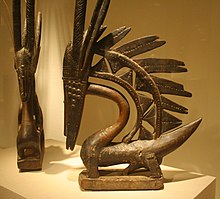
The Bambara people (Bambara: Bamanankaw) adapted many artistic traditions and began to create display pieces. Before money was the main drive for creation of their artworks they used their abilities solely as a sacred craft for display of spiritual pride, religious beliefs and display of customs. Example artworks include the Bamana n'tomo mask. Other statues were created for people such as hunters and farmers so others could leave offerings after long farming seasons or group hunts. The stylistic variations in Bambara art are extreme sculptures, masks and headdresses that display either stylized or realistic features, and either weathered or encrusted patinas. Until quite recently, the function of Bambara pieces was shrouded in mystery, but in the last twenty years, field studies have revealed that certain types of figures and headdresses were associated with a number of the societies that structure Bambara life. During the 1970s a group of approximately twenty figures, masks and TjiWara headdresses belonging to the so-called 'Segou style' were identified. The style is distinct and recognizable by its typical flat faces, arrow-shaped noses, all-over body triangular scarifications and, on the figures, splayed hands.
- Masks
There are three major and one minor type of Bambara mask. The first type, used by the N'tomo society, has a typical comb-like structure above the face, is worn during dances and may be covered with cowrie shells. The second type of mask, associated with the Komo society, has a spherical head with two antelope horns on the top and an enlarged, flattened mouth. They are used during dances, but some have a thickly encrusted patina acquired during other ceremonies in which libations are poured over them.
The third type has connections with the Nama society and is carved in the form of an articulated bird's head, while the fourth, minor type, represents a stylized animal head and is used by the Kore society. Other Bambara masks are known to exist, but unlike those described above, they cannot be linked to specific societies or ceremonies. Bambara carvers have established a reputation for the zoomorphic headdresses worn by Tji-Wara society members. Although they are all different, they all display a highly abstract body, often incorporating a zig-zag motif, which represents the sun's course from east to west, and a head with two large horns. Bambara members of the Tji-Wara society wear the headdress while dancing in their fields at sowing time, hoping to increase the crop yield.
- Statuettes
Statuettes are a cornerstone of African art, embodying the continent's deep cultural, spiritual, and social values. These small, often intricately crafted sculptures transcend mere decorative purposes, serving as powerful symbols of identity, ritual, and community. Found across diverse African regions, statuettes vary widely in style, material, and function but share a common thread of storytelling and cultural significance.
- Spiritual Significance: Many African statuettes are created to honor ancestors, deities, or spirits. They are often used in religious ceremonies or placed in shrines to serve as intermediaries between the human and spiritual worlds. For example, the Bakongo Nkisi figures from Central Africa are believed to harness spiritual energy for protection, healing, or justice.
- Representation of Life Stages and Roles: Statuettes often depict key aspects of human life, such as fertility, motherhood, initiation, and leadership. The Akua’ba fertility dolls of the Akan people in Ghana symbolize the hope for healthy children, while sculptures of chiefs or elders reflect authority and wisdom.
Other Bambara figures, called Dyonyeni, are thought to be associated with either the southern Dyo society or the Kwore society. These female or hermaphrodite figures usually appear with geometric features such as large conical breasts and measure between 40 and 85 cm in height. The blacksmith members of the Dyo society used them during dances to celebrate the end of their initiation ceremonies. They were handled, held by dancers and placed in the middle of the ceremonial circle.
Among the corpus of Bambara figures, Boh sculptures are perhaps the best known. These statues represent a highly stylized animal or human figure, and are made of wood which is repeatedly covered in thick layers of earth impregnated with sacrificial materials such as millet, chicken or goat blood, kola nuts and alcoholic drinks. They were employed by the Kono and the Komo societies and served as receptacles for spiritual forces, and could, in turn, be used for apotropaic purposes.
Each special creative trait a person obtained was seen as a different way to please higher spirits.
Dogon
[edit]Dogon art consists primarily of sculptures. Their art revolves around Dogon religious values, ideals, and freedoms (Laude, 19). Dogon sculptures are not made to be seen publicly, and are commonly hidden from the public eye within the houses of families, sanctuaries, or kept with the Hogon (Laude, 20). The importance of secrecy is due to the symbolic meaning behind the pieces and the process by which they are made.
Themes found throughout Dogon sculpture consist of figures with raised arms, superimposed bearded figures, horsemen, stools with caryatids, women with children, figures covering their faces, women grinding pearl millet, women bearing vessels on their heads, donkeys bearing cups, musicians, dogs, quadruped-shaped troughs or benches, figures bending from the waist, mirror-images, aproned figures, and standing figures (Laude, 46–52). Signs of other contacts and origins are evident in Dogon art. The Dogon people were not the first inhabitants of the cliffs of Bandiagara. Influence from Tellem art is evident in Dogon art because of its rectilinear designs (Laude, 24).
Dogon art is extremely versatile, although common stylistic characteristics – such as a tendency towards stylization – are apparent on the statues. Their art deals with the myths whose complex ensemble regulates the life of the individual. The sculptures are preserved in innumerable sites of worship, personal or family altars, altars for rain, altars to protect hunters, in market. As a general characterization of Dogon statues, one could say that they render the human body in a simplified way, reducing it to its essentials. Some are extremely elongated with emphasis on geometric forms. The subjective impression is one of immobility with a mysterious sense of solemn gravity and serene majesty, although conveying at the same time a latent movement. Dogon sculpture recreates the hermaphroditic silhouettes of the Tellem, featuring raised arms and a thick patina made of blood and millet beer. The four Nommo couples, the mythical ancestors born of the god Amma, ornament stools, pillars or men's meeting houses, door locks, and granary doors. The primordial couple is represented sitting on a stool, the base of which depicts the earth while the upper surface represents the sky; the two are interconnected by the Nommo. The seated female figures, their hands on their abdomen, are linked to the fertility cult, incarnating the first ancestor who died in childbirth, and are the object of offerings of food and sacrifices by women who are expecting a child.
Kneeling statues of protective spirits are placed at the head of the dead to absorb their spiritual strength and to be their intermediaries with the world of the dead, into which they accompany the deceased before once again being placed on the shrines of the ancestors. Horsemen are reminders of the fact that, according to myth, the horse was the first animal present on earth. The Dogon style has evolved into a kind of cubism: ovoid head, squared shoulders, tapered extremities, pointed breasts, forearms, and thighs on a parallel plane, hairdos stylized by three or four incised lines. Dogon sculptures serve as a physical medium in initiations and as an explanation of the world. They serve to transmit an understanding to the initiated, who will decipher the statue according to the level of their knowledge. Carved animal figures, such as dogs and ostriches, are placed on village foundation altars to commemorate sacrificed animals, while granary doors, stools and house posts are also adorned with figures and symbols.
There are nearly eighty styles of masks, but their basic characteristic is great boldness in the use of geometric shapes, independent of the various animals they are supposed to represent. The structure of a large number of masks is based on the interplay of vertical and horizontal lines and shapes. Another large group has triangular, conic shapes. All masks have large geometric eyes and stylized features. The masks are often polychrome, but on many, the color is lost; after the ceremonies, they were left on the ground and quickly deteriorated because of termites and other conditions. The Dogon continue an ancient masquerading tradition, which commemorates the origin of death. According to their myths, death came into the world as a result of primeval man's transgressions against the divine order. Dama memorial ceremonies are held to accompany the dead into the ancestral realm and restore order to the universe. The performance of masqueraders – sometimes as many as 400 – at these ceremonies is considered necessary. In the case of the dama, the timing, types of masks involved, and other ritual elements are often specific to one or two villages and may not resemble those seen in locations only several kilometres distant. The masks also appear during baga-bundo rites performed by small numbers of masqueraders before the burial of a male Dogon. Dogon masks evoke the form of animals associated with their mythology, yet their significance is only understood by the highest ranking cult members whose role is to explain the meaning of each mask to a captivated audience.
-
Person who wears a Satimbe mask
-
Figure of a kneeling woman; circa 1500; wood; height: 35.2 cm (137⁄8 in.); Metropolitan Museum of Art (New York City)
-
Equestrian figure; 16th–17th century; wood; height: 68.9 cm (271⁄8 in.); Metropolitan Museum of Art
-
Stool; possibly late 19th to early 20th century; wood & pigment; National Museum of African Art (Washington D.C., USA)
Other ethnic groups of Mali
[edit]-
Black and white picture of a female figure with raised arm; 15th–17th century; wood (ficus, moraceae), sacrificial materials; height: 44.8 cm (175⁄8 in.); by the Tellem people; Metropolitan Museum of Art (New York City)
-
Zoomorphic figurine; 12th-16th century; by Tennenkou culture; Museo de Arte Africano Arellano Alonso (Valladolid, Spain)
-
Equestrian figurine; by Bankoni culture; Museo de Arte Africano Arellano Alonso
Burkina Faso
[edit]
Burkina Faso is a small, landlocked country north of Ghana and south of Mali and Niger. Economically, it is one of the four or five poorest countries worldwide. Culturally, it is extremely rich. In part, this is because so few people from Burkina have become Muslim or Christian.[54] Many of the ancient artistic traditions for which Africa is so well known have been preserved in Burkina Faso because so many people continue to honor the ancestral spirits and the spirits of nature. In great part, they honor the spirits through the use of masks and carved figures. Many of the countries to the north of Burkina Faso have become predominantly Muslim, while many of the countries to the south of Burkina Faso are heavily Christian. In contrast, many of the people of Burkina Faso continue to offer prayers and sacrifices to the spirits of nature and to the spirits of their ancestors. The result is that they continue to use the sorts of art that we see in museums in Europe and America.[55]
One of the principal obstacles to understanding the art of Burkina Faso, including that of the Bwa, has been confusion between the styles of the Bwa, "gurunsi", and Mossi, and confusion of the Bwa people with their neighbors to the west the Bobo people. This confusion was the result of the use by French colonial officers of Jula interpreters at the turn of the century. these interpreters considered the two peoples to be the same and so referred to the Bobo as "Bobo-Fing" and to the Bwa as "Bobo-Oule." In fact, these two peoples are not related at all. Their languages and social systems are quite different, and so is their art. In terms of artistic styles, the confusion stems from the fact that the Bwa, "gurunsi'" and Mossi make masks that are covered with red white and black geometric graphic patterns. This is simply the style of the Voltaic or Gur peoples, and also includes the Dogon and other peoples who speak Voltaic languages.[56]
Ivory Coast(Côte d'Ivoire)
[edit]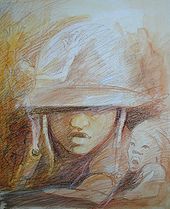
The Baoulé, the Senoufo and the Dan peoples are skilled at carving wood and each culture produces wooden masks in wide variety. The Ivorian people use masks to represent animals in caricature to depict deities, or to represent the souls of the departed.
As the masks are held to be of great spiritual power, it is considered taboo for anyone other than specially trained persons or chosen ones to wear or possess certain masks. These ceremonial masks are each thought to have a soul, or life force, and wearing these masks is thought to transform the wearer into the entity the mask represents.
Ivory Coast(Côte d'Ivoire) also has modern painters and illustrators. Gilbert G. Groud[57] criticizes the ancient beliefs in black magic, as held with the spiritual masks mentioned above, in his illustrated book Magie Noire.
East Africa
[edit]East Africa, a region encompassing countries like Kenya, Tanzania, Uganda, Rwanda, Burundi, and Ethiopia, boasts a rich and diverse artistic heritage. From traditional crafts to contemporary expressions, East African art reflects the region’s vibrant history, cultural complexity, and evolving identity in the global arena.
Kenya
[edit]Around Lake Turkana exist ancient petroglyphs depicting human figures and animals. Bantu tribes build funeral posts and carvings of human heads atop geometric designs are still created. Though the original posts no longer exist, these more recent creations are thought to be a continuation of the practice. The Kikuyu people also continue the designs of ancient tradition in the designs painted on their shields.[58]
Bantu contemporary Kenyan artists include Elimo Njau, founder of the Paa Ya Paa Art Centre, a Nairobi-based artists workshop.[59] From the University of Nairobi School of Fine Art and Design came Bulinya Martins and Sarah Shiundu. The two, by having learned many basic techniques in design, are highly innovative both in style, use of color and execution. Unlike most contemporary Kenyan artists, they paint using oils, acrylics and watercolors and/or combinations.[60][61]
The Eskenazi Museum of Art at Indiana University has a large collection of traditional art objects from Kenya including jewelry, containers, weapons, walking sticks, headrests, stools, utensils, and other objects available online.[62]
Ethiopia
[edit]
Ethiopian art from the 4th century until the 20th can be divided into two broad groupings. First comes a distinctive tradition of Christian art, mostly for churches, in forms including painting, crosses, icons, illuminated manuscripts, and other metalwork such as crowns. Secondly, there are popular arts and crafts such as textiles, basketry and jewellery, in which Ethiopian traditions are closer to those of other peoples in the region. Its history goes back almost three thousand years to the kingdom of D'mt. The Ethiopian Orthodox Tewahedo Church has been the predominant religion in Ethiopia for over 1500 years, for most of this period in a very close relation, or union, with the Coptic Christianity of Egypt, so that Coptic art has been the main formative influence on Ethiopian church art.

Prehistoric rock art comparable to that of other African sites survives in a number of places and, until the arrival of Christianity, stone stelae, often carved with simple reliefs, were erected as grave markers and for other purposes in many regions; Tiya is one important site. The "pre-Axumite" Iron Age culture of about the 5th century BCE to the 1st century CE was influenced by the Kingdom of Kush to the north, and settlers from Arabia, and produced cities with simple temples in stone, such as the ruined one at Yeha, which is impressive[opinion] for its date in the 4th or 5th century BCE.
The powerful Kingdom of Aksum emerged in the 1st century BCE and dominated Ethiopia until the 10th century, having become very largely Christian from the 4th century.[63] Although some buildings and large, pre-Christian stelae exist, there appears to be no surviving Ethiopian Christian art from the Axumite period. However, the earliest works remaining show a clear continuity with Coptic art of earlier periods. There was considerable destruction of churches and their contents in the 16th century when the country was invaded by Muslim neighbours. The revival of art after this was influenced by Catholic European art in both iconography and elements of style, but retained its Ethiopian character. In the 20th century, Western artists and architects began to be commissioned by the government, and to train local students, and more fully Westernized art was produced alongside continuations of traditional church art.[63]
Church paintings in Ethiopia were likely produced as far back as the introduction of Christianity in the 4th century AD,[64] although the earliest surviving examples come from the church of Debre Selam Mikael in the Tigray Region, dated to the 11th century AD.[65] However, the 7th-century AD followers of the Islamic prophet Muhammad who fled to Axum in temporary exile mentioned that the original Church of Our Lady Mary of Zion was decorated with paintings.[65] Other early paintings include those from the rock-hewn churches of Lalibela, dated to the 12th century AD, and in nearby Genete Maryam, dated to the 13th century AD.[65] However, paintings in illuminated manuscripts predate the earliest surviving church paintings; for instance, the Ethiopian Garima Gospels of the 4th–6th centuries AD contain illuminated scenes imitating the contemporary Byzantine style.[66]
Ethiopian painting, on walls, in books, and in icons,[67] is highly distinctive, though the style and iconography are closely related to the simplified Coptic version of Late Antique and Byzantine Christian art. From the 16th century, Roman Catholic church art and European art in general began to exert some influence. However, Ethiopian art is highly conservative and retained much of its distinct character until modern times. The production of illuminated manuscripts for use continued up to the present day.[68]
Another important form of Ethiopian art, also related to Coptic styles, is crosses made from wood and metal.[69][70] They are usually copper alloy or brass, plated (at least originally) with gold or silver. The heads are typically flat cast plates with elaborate and complex openwork decoration. The cross motif emerges from the decoration, with the whole design often forming a rotated square or circular shape, though the designs are highly varied and inventive. Many incorporate curved motifs rising from the base, which are called the "arms of Adam". Except in recent Western-influenced examples, they usually have no corpus, or figure of Christ, and the design often incorporates numerous smaller crosses. Engraved figurative imagery has sometimes been added. Crosses are mostly either processional crosses, with the metal head mounted on a long wooden staff, carried in religious processions and during the liturgy, or hand crosses, with a shorter metal handle in the same casting as the head. Smaller crosses worn as jewellery are also common.
Ethiopia has great ethnic and linguistic diversity, and styles in secular traditional crafts vary greatly in different parts of the country. There are a range of traditions in textiles, many with woven geometric decoration, although many types are also usually plain. Ethiopian church practices make a great deal of use of colourful textiles, and the more elaborate types are widely used as church vestments and as hangings, curtains and wrappings in churches, although they have now largely been supplanted by Western fabrics. Examples of both types can be seen in the picture at the top of the article. Icons may normally be veiled with a semi-transparent or opaque cloth; very thin chiffon-type cotton cloth is a speciality of Ethiopia, though usually with no pattern.
Colourful basketry with a coiled construction is common in rural Ethiopia. The products have many uses, such as storing grains, seeds and food and being used as tables and bowls. The Muslim city of Harar is well known for its high-quality basketry,[71] and many craft products of the Muslim minority relate to wider Islamic decorative traditions.
Tanzania
[edit]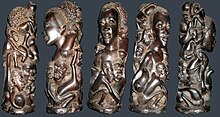
Art from Tanzania is known for paintings by modern artists like Tinga Tinga or George Lilanga, and for traditional as well as modern Makonde sculptures. Like in other regions, there is also a diversified tradition of producing textile art.[9]
Tinga Tinga art has roots in decorating hut walls in central and south Tanzania. It was first in 1968 when Edward Said Tingatinga started to paint on wooden sheets with enamel colours when Tinga Tinga art became known. The art of the Makonde must be subdivided into different areas. The Makonde are known as master carvers throughout East Africa and their statuary can be found being sold in tourist markets and museums alike. They traditionally carve household objects, figures and masks. Since the 1950s the so-called Modern Makonde Art has been developed. An essential step was the turning to abstract figures, mostly spirits (Shetani) that play a special role. Makonde are also part of the important contemporary artists of Africa today. An outstanding position is taken by George Lilanga.
Central Africa
[edit]Democratic Republic of Congo
[edit]Kuba Kingdom
[edit]The Kuba Kingdom (also rendered as the Kingdom of the Bakuba, Songora or Bushongo) was a pre-colonial kingdom in Central Africa. The Kuba Kingdom flourished between the 17th and 19th centuries in the region bordered by the Sankuru, Lulua, and Kasai rivers in the south-east of the modern-day Democratic Republic of the Congo. A great deal of the art was created for the courts of chiefs and kings and was profusely decorated, incorporating cowrie shells and animal skins (especially leopard) as symbols of wealth, prestige and power. Masks are also important to the Kuba. They are used both in the rituals of the court and in the initiation of boys into adulthood, as well as at funerals.
-
Ngady-Mwash mask; 19th century; Ethnological Museum of Berlin (Germany). The colors, red, brown & beige create a warm atmosphere of a savanna, in contrast with the rows of blue beads. Like many other Kuba masks, this one is decorated with cowrie shells. Like many Kuba types of masks, the ngady-mwash mask is extensively polychromed, or multicolored.
-
Mulwalwa mask; 19th or early 20th century; painted wood and raffia; Ethnological Museum of Berlin. This mask embodies a powerful nature spirit. As there are no holes through which a performer could see, it was probably mounted on a wall at an initiation camp, signalling that the initiation was almost complete.
-
Pwoom Itok mask; late 19th century; 39.1 x 28.6 x 29.8 cm (153⁄8 x 111⁄4 x 113⁄4 in.); Brooklyn Museum (USA). This mask may have represented a wise older man at boys' initiations. One of the principal Kuba dance masks is called pwoom itok. The chief identifying characteristic is the shape of the eyes, whose centers are cones surrounded by holes through which the wearer sees.
-
Belt (Yet); possibly early 1900s; cord, leather, glass beads, shells; Cleveland Museum of Art (USA). Like some of the masks, this belt is decorated with colorful beads.
-
Ndop of King Mishe miShyaang maMbul; 1760–1780; wood; 49.5 x 19.4 x 21.9 cm (191⁄2 x 75⁄8 x 85⁄8 in.); Brooklyn Museum (New York City). Ndops are royal memorial portraits carved by the Kuba people of Central Africa. They are not naturalistic portrayals but are intended as representations of the king's spirit and as an encapsulation of the principle of kingship.
-
Head goblet (Mbwoongntey); 19th century; wood; Brooklyn Museum. It has a one-inch cylindrical lip with linear decoration. The hair is made up of crosshatched lines with a raised diamond-shaped segment on the back of the head. Its cheeks have curved multilinear scarification.
-
Itoon (diviner's instrument, in form of a hippopotamus); 19th century; wood; 7.5 × 26.6 × 6.4 cm (215⁄16 × 101⁄2 × 21⁄2 in.); Brooklyn Museum
-
Cloth; raffia; 20.3 x 85.7 cm (8 x 333⁄4 in.); Brooklyn Museum. In Kuba culture, men are responsible for raffia palm cultivation and the weaving of raffia cloth.[72] Several types of raffia cloth are produced for different purposes, the most common form of which is a plain woven cloth that is used as the foundation for decorated textile production.
Luba Kingdom
[edit]The Kingdom of Luba or Luba Empire (1585–1889) was a pre-colonial Central African state that arose in the marshy grasslands of the Upemba Depression in what is now the southern part of the Democratic Republic of Congo. Today, the Luba people or baLuba are an ethno-linguistic group indigenous to the south-central region of the Democratic Republic of the Congo.[73] The majority of them live in this country, residing mainly in its Katanga, Kasai, and Maniema provinces.
As in the Kuba Kingdom, the Luba Kingdom held the arts in high esteem. A carver held relatively high status, which was displayed by an adze (axe) that he carried over his shoulder. Luba art was not very uniform because of the vast territory which the kingdom controlled. However, some characteristics are common. The important role of women in the creation myths and political society resulted in many objects of prestige being decorated with female figures.
-
Headrest; 19th century; wood; height: 18.5 cm (7.3 in), width: 19 cm (7.5 in), thickness: 8 cm (3.1 in); Musée du quai Branly (Paris). This headrest presents 19th century Luba hairstyles, as well as the long limbs, bent-back legs, cylindrical torso and dynamic pose typical of the artist who made it.
-
Figurine of a standing woman; late 19th or early 20th century; wood; 27.9 × 8.3 × 10.2 cm (11 × 31⁄4 × 4 in.); Brooklyn Museum (New York City)
-
Heddle pulley with female head; late 19th or early 20th century; wood; 20.6 × 5.4 × 4.8 cm (81⁄8 × 21⁄8 × 17⁄8 in); Brooklyn Museum
-
Kifwebe mask; wood; Royal Museum for Central Africa (Tervuren, Belgium)
Other ethnic groups of Democratic Republic of Congo
[edit]-
Anthropomorphic pot; early 20th century; pottery; 40.0 × 24.0 cm (153⁄4 × 91⁄2 in.); by Mangbetu people; Brooklyn Museum (New York City)
-
Plank mask (emangungu); possibly early 1900s; wood; by Bembe people; Cleveland Museum of Art (USA)
-
Head of a scepter; 19th century; by Yombe people
-
Female figure; 20th century; wood; by Lumbo people; Indianapolis Museum of Art (USA)
-
Mask; early 20th century; wood, raffia & color pigments; by Yaka people; Rietberg Museum (Zürich, Switzerland)
-
Chair (throne) of a chief; 19th or early 20th century; wood; by Hemba people; Rietberg Museum
-
Funerary figure (tumba); 19th century; wood; by Sundi people; Rietberg Museum
-
Mbangu mask; wood, pigment & fibres; height: 27 cm; by Pende people; Royal Museum for Central Africa. Representing a disturbed man, the hooded V-looking eyes and the mask's artistic elements – face surfaces, distorted features, and divided colour – evoke the experience of personal inner conflict
-
Tomb figure; soapstone; by Boma people; Royal Museum for Central Africa. Stone sculptures are extremely rare in African art
-
Warrior ancestor figure; 19th century; wood; 84.1 cm × 26 cm × 23.2 cm (33.1 in × 10.2 in × 9.1 in); by Hemba people; Kimbell Art Museum (Fort Worth, Texas, USA)
-
Statuette of a woman; 19th century or early 20th century; by Holoholo people; Ethnological Museum of Berlin (Germany)
Chad
[edit]Sao
[edit]The Sao civilization in Middle Africa from circa the 6th century BC to as late as the 16th century AD, lived by the Chari River around Lake Chad in territory that later became part of Cameroon and Chad. Their most important artworks are the terracotta figurines. These figurines represent humans and animals. Other kinds of artifacts show that the Saos were skilled workers in bronze, copper, and iron.[74]
-
Anthropomorphic figurine; terracotta; 9th-16th century; Musée du quai Branly (Paris)
-
Anthropomorphic figurine; 9th-16th century; terracotta; Musée du quai Branly
-
Anthropomorphic figurine; 9th-16th century; terracotta; Musée du quai Branly
-
Anthropomorphic figurine; 9th-16th century; terracotta; Musée du quai Branly
-
Head; terracotta; Muséum d'Histoire naturelle de La Rochelle (La Rochelle, France)
-
Zoomorphic figure; 9th-16th century; terracotta; Musée du quai Branly
-
Fragment of a pectoral; 9th-16th century; cuprous alloy; Musée du quai Branly
Gabon
[edit]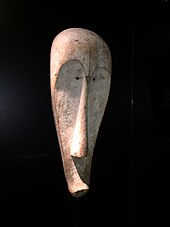
The Fang people make masks and basketry, carvings, and sculptures. Fang art is characterized by organized clarity and distinct lines and shapes. Bieri, boxes to hold the remains of ancestors, are carved with protective figures. Masks are worn in ceremonies and for hunting. The faces are painted white with black features. Myene art centers around Myene rituals for death. Female ancestors are represented by white painted masks worn by male relatives. The Bekota use brass and copper to cover their carvings. They use baskets to hold ancestral remains. Tourism is rare in Gabon, and unlike in other African countries, art is not spurred on by commerce.
Southern Africa
[edit]Botswana
[edit]In the northern part of Botswana, women in the villages of Etsha and Gumare[75] are noted for their skill at crafting baskets from Mokola Palm and local dyes. The baskets are generally woven into three types: large, lidded baskets used for storage; large, open baskets for carrying objects on the head or for winnowing threshed grain, and smaller plates for winnowing pounded grain. The artistry of these baskets is being steadily enhanced through color use and improved designs as they are increasingly produced for commercial use.
The oldest evidence is ancient paintings from both Botswana and South Africa. Depictions of hunting, both animal and human figures were made by the San people dating before civilization over 20,000 years old within the Kalahari desert.
Zimbabwe
[edit]The culture from Great Zimbabwe left more impressive buildings than sculpture,[opinion] but the eight soapstone Zimbabwe Birds appear to have had a special significance and were presumably mounted on monoliths. Modern Zimbabwean sculptors in soapstone have achieved considerable international success. Southern Africa's oldest known clay figures date from 400 to 600 AD and have cylindrical heads with a mixture of human and animal features.
South Africa
[edit]Mapungubwe
[edit]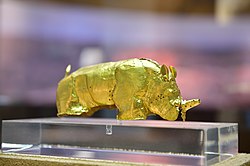
Kingdom of Mapungubwe (1075–1220) was a pre-colonial state in Southern Africa located at the confluence of the Shashe and Limpopo rivers, south of Great Zimbabwe. The most famous Mapungubwe artwork is a tiny golden rhino, known as the golden rhinoceros of Mapungubwe. In other graves from Mapengubwe were found objects made of iron, gold, copper, ceramic and glass beads.
Southern Ndebele
[edit]The Southern Ndebele people are famous for the way they paint their houses. Distinct geometric forms against stark, contrasting colours form the basis of the Ndebele style, which encompassed everything from the architecture, clothing and tools of the people. While color has almost always had a role in drawing emotions in art, the Ndebele were one of the first Southern African tribes to utilise a wide array of colours to convey specific meanings as part of their very lives.
-
Murals in the Ndebele from the Maastricht University (the Netherlands)
-
Murals in the Ndebele from the Maastricht University
-
A beaded apron or meputo; late 19th-early 20th century; hide, glass beads, metal beads, straw; 46.9 cm × 50.8 cm (18.5 in × 20.0 in); Birmingham Museum of Art (Alabama, USA)
North Africa
[edit]African art is rarely created for art’s sake; it often carries symbolic meaning related to community values, ancestral reverence, or spiritual beliefs. For example, masks represent spirits or deities, and sculptures can symbolize fertility, protection, or wisdom.
Rock Art and Prehistoric Art:
North Africa's artistic heritage dates back to prehistoric times, evidenced by rock art in the Sahara Desert. Sites like Tassili n'Ajjer in Algeria feature thousands of petroglyphs and paintings, depicting animals, hunting scenes, and daily life from as far back as 10,000 BCE. These works reflect the relationship between early humans and their environment.
Egypt
[edit]Persisting for 3,000 years and thirty dynasties, the "official" art of Ancient Egypt was centred on the state religion of the time. The art ranged from stone carvings of both massive statues and small statuettes to wall art that depicted both history and mythology. In 2600 BC the maturity of Egyptian carving reached a peak it did not reach again for another 1,500 years during the reign of Rameses II.[76]
A lot of the art possesses a certain stiffness, with figures poised upright and rigid in a regal fashion. Bodily proportions also appear to be mathematically derived, giving rise to a sense of fantastic perfection in the figures depicted. This most likely was used to reinforce the godliness of the ruling caste.
-
Both sides of the Narmer Palette; circa 3100 BC; greywacke; height: 63 cm (243⁄4 in.); from Hierakonpolis (Egypt); Egyptian Museum (Cairo). The Narmer palette is the quintessential statement of the Egyptians' mythology of kingship. A clear manifesto of royal power, it is also one with multiple layers of symbolism.
-
Stele of Princess Nefertiabet eating; 2589-2566 BC; limestone & paint; height: 37.7 cm (147⁄8 in.), length: 52.5 cm (205⁄8 in.), depth: 8.3 cm (31⁄4 in.); from Giza; Louvre (Paris). This finely executed relief represents the most succinct assurance of perpetual offering for the deceased.
-
The Bust of Nefertiti; 1352-1336 BC; limestone, plaster & paint; height: 48 cm (197⁄8 in.); from Amarna (Egypt); Egyptian Museum of Berlin (Germany). Perhaps the most iconic image of a woman from the ancient world, the Bust of Nefertiti is difficult to contextualize because it seems so exceptional.
-
The Mask of Tutankhamun; circa 1327 BC; gold, glass and semi-precious stones; height: 54 cm (211⁄4 in.), width: 39.3 cm (151⁄2 in.), depth: 49 cm (191⁄4 in.); from the Valley of the Kings (Thebes, Egypt); Egyptian Museum. The mummy mask of Tutankhamun is perhaps the most iconic object to survive from ancient Egypt.
Nubia and Sudan
[edit]The people of Nubia, living in southern Egypt and the northern region of Sudan, developed historical art styles similar to that of their Egyptian neighbors to the north. However, Nubian art was not merely a product of colonization by ancient Egypt, but rather due to a mutual exchange of ideas and ideologies along the Nile Valley. The earliest art of the region comes from the Kerma culture, which was contemporary to Old and Middle Kingdom Egypt. Art from this period exhibits Egyptian faience along with distinct black-topped pottery of Nubian origin. In the latter Napatan period of the Kingdom of Kush, art showed more influence from Egypt as the people in the region were worshiping Egyptian gods.[77][78]
After these historical periods, the inhabitants of Sudan created artworks in different styles, both in indigenous African ways or influenced by Byzantine Christian, Islamic and modern art traditions.[79]
African Diaspora
[edit]Museums
[edit]
Many art and ethnographic museums have a section dedicated to the art from Sub-Saharan Africa, such as the British Museum, Musée du Quai Branly – Jacques Chirac in Paris, Metropolitan Museum of Art in New York and the Ethnological Museum of Berlin. Not many Western museums are dedicated only to African art, like the Africa Museum in Brussels, National Museum of African Art in Washington, D.C., and African Art Museum of Maryland in Columbia, Maryland.[80] Some colleges and universities hold collections of African art, like Howard University in Washington, DC and Spelman College in Atlanta, Georgia.
Nearly all countries in Africa have at least a national museum housing African art, often very largely from that country, such as the Sierra Leone National Museum and Nigerian National Museum in Lagos. There are also many smaller museums in the provinces.
The display of African art and artifacts in European museums has long been controversial in various ways, and the French-commissioned "Report on the restitution of African cultural heritage" (2018) has marked a key moment, leading to an increase in the return of artifacts. However, there are other examples, such as the Museum of African Art in Belgrade which was opened in 1977 because of Yugoslavia's relations with many African countries thanks to the Non-Aligned Movement. The museum was opened out of the desire to acquaint the people of Yugoslavia with the art and culture of Africa since there was a deeply rooted notion about Yugoslavia sharing a friendship with African countries thanks to their similar struggles; all of the original items in the museums were legally bought by the Yugoslav ambassador and journalist Zdravko Pečar and his wife Veda Zagorac, while more recent acquisitions were either bought by the museum, received as gifts from Yugoslavs who lived in Africa, or were diplomatic gifts to the museum by the ambassadors of African countries.[81]
The Congolese activist Mwazulu Diyabanza has taken direct action against European museums to take back items he says belong to Africa.[82][83]
See also
[edit]- Culture of Africa
- Contemporary African art
- African art in Western collections
- African folk art
- African traditional masks
- Tribal art
- The Africa Center
- Category:African artists
Notes
[edit]References
[edit]- ^ Fortenberry, Diane (2017). The Art Museum. Phaidon. pp. 309, 314. ISBN 978-0-7148-7502-6.
- ^ Suzanne Blier: "Africa, Art, and History: An Introduction", A History of Art in Africa, pp. 15–19
- ^ Ross, Emma George (October 2002). "African Christianity in Ethiopia". The Metropolitan Museum of Art.
- ^ Kino, Carol (2012-10-26). "When Artifact 'Became' Art". The New York Times. Retrieved 2014-12-12.
- ^ Breunig, Peter (2014), Nok: African Sculpture in Archaeological Context, Frankfurt: Africa Magna Verlag, ISBN 978-3-937248-46-2.
- ^ a b Mitchell, Peter and Lane, Paul (2013) The Oxford Handbook of African Archaeology. Oxford University Press. p. 375. ISBN 0191626147
- ^ a b Henshilwood, Christopher S.; et al. (2011). "A 100,000-Year-Old Ochre-Processing Workshop at Blombos Cave, South Africa". Science. 334 (6053): 219–222. Bibcode:2011Sci...334..219H. doi:10.1126/science.1211535. PMID 21998386. S2CID 40455940.
- ^ a b McBrearty, Sally; Brooks, Allison (2000). "The revolution that wasn't: a new interpretation of the origin of modern human behavior". Journal of Human Evolution. 39 (5): 453–563. doi:10.1006/jhev.2000.0435. PMID 11102266.
- ^ a b Honour & Fleming, 557
- ^ a b c Murrell, Denise. "African Influences in Modern Art", The Metropolitan Museum of Art, April 2008. Retrieved on 31 January 2013.
- ^ Mark, Peter (1999). "Is There Such a Thing as African Art?". Record of the Art Museum, Princeton University. 58 (1/2): 7–15. doi:10.2307/3774788. JSTOR 3774788.
- ^ Honour & Fleming, 556–561
- ^ Vangheluwe, S.; Vandenhoute, J. (2001). The Artist Himself in African Art Studies: Jan Vandenhoute's Investigation of the Dan Sculptor in Côte D'Ivoire. Academia Press. p. 19. ISBN 9789038202860. Retrieved 2014-12-12.
- ^ Suzanne Blier, "Africa, Art, and History: An Introduction", A History of Art in Africa, p. 16
- ^ Art of central africa Retrieved 28 April 2022
- ^ "The Use of Haematite, Tiger's Eye Stone and Ebony Wood for African Jewelry". Squinti African Art. Archived from the original on 2012-01-19. Retrieved 2012-01-15.
- ^ "What is African Art". Squinti African Art. Archived from the original on 2012-01-19. Retrieved 2012-01-15.
- ^ "African Art and Architecture". Funk & Wagnalls New World Encyclopedia. Chicago: World Book, Inc. 30 September 2021. Retrieved 11 December 2023 – via EBSCOhost.
- ^ Olupọna, Jacob J. (2014-01-09), "Sacred arts and ritual performances", African Religions, Oxford University Press, pp. 72–88, doi:10.1093/actrade/9780199790586.003.0005, ISBN 978-0-19-979058-6, retrieved 2024-10-06
- ^ Vogel, Susan Mullin (1997). Baule: African Art, Western Eyes. Yale University Press. ISBN 978-0300073172.
{{cite book}}: Check|isbn=value: checksum (help) - ^ "African Deities and Their Artistic Representations". Retrieved 2024-10-06.
- ^ Bourdillon, Michael F. C. (1975-03-10). "Themes in the Understanding of Traditional African Religion". Journal of Theology for Southern Africa. University of KwaZulu-Natal: 37–50. ISSN 0047-2867 – via EBSCOhost.
- ^ Gill, Michael (1992). Sacred Textiles of West Africa. British Museum Press. ISBN 978-0714116195.
{{cite book}}: Check|isbn=value: checksum (help) - ^ Yong, Ed (15 March 2018). "A Cultural Leap at the Dawn of Humanity - New finds from Kenya suggest that humans used long-distance trade networks, sophisticated tools, and symbolic pigments right from the dawn of our species". The Atlantic. Retrieved 15 March 2018.
- ^ ""New" Giraffe Engravings Found". The 153 Club. Archived from the original on 12 June 2007. Retrieved 2007-05-31.
- ^ a b Breunig (2014). Nok: African Sculpture in Archaeological Context. Africa Magna Verlag. p. 21. ISBN 9783937248462.
- ^ Pietz, William (March 1985). "The Problem of the Fetish, I". Res: Anthropology and Aesthetics. 9: 5–17. doi:10.1086/resv9n1ms20166719. ISSN 0277-1322.
- ^ Strother, Z. S. (2011). À la recherche de l’Afrique dans Negerplastik de Carl Einstein. Gradhiva, 14: 30–55. link.
- ^ Mashabane, Phill (2018). "Africanism in art and architecture: The keynote address delivered at the twelfth annual conference of the South African Journal of Art History". South African Journal of Art History. 33 (3): iv-vii.
- ^ Richardson, John (2007). A Life of Picasso: The Cubist Rebel, 1907–1916. New York: Knopf. ISBN 978-0-375-71150-3.
- ^ Magnin, André (2005). Arts of Africa: Jean Pigozzi's Contemporary Collection. Milan: Skira. ISBN 88-7624-296-1.
- ^ Enwezor, Okwui (2010). Events of the Self: Portraiture and Social Identity: Contemporary African Photography from the Walther Collection. Göttingen: Steidl. ISBN 978-3-86930-157-0.
- ^ Kampen-O'Riley, Michael (2013). Art beyond the West: the arts of the Islamic world, India and Southeast Asia, China, Japan and Korea, the Pacific, Africa, and the Americas (3rd ed.). Upper Saddle River. ISBN 9780205887897. OCLC 798221651.
{{cite book}}: CS1 maint: location missing publisher (link) - ^ Ross, Doran H. (April 1994). "Coffins With Style". Faces. Vol. 10, no. 8. Cricket Media. p. 33. ISSN 0749-1387 – via EBSCOhost MAS Ultra: School Edition.
- ^ "Joseph Bertiers, Kenya". AFRICANAH.ORG. 2016-09-04. Retrieved 2020-10-18.
- ^ Extreme Canvas 2 : The Golden Age of Hand-Painted Movie Posters from Ghana. Wolfe III, Ernie (1st ed.). [Los Angeles, CA]: Kesho & Malaika Press. 2012. ISBN 978-0-615-54525-7. OCLC 855806853.
{{cite book}}: CS1 maint: others (link) - ^ Brown, Ryan Lenora (2016-02-04). "How Ghana's Gory, Gaudy Movie Posters Became High Art". The Atlantic. Retrieved 2020-10-18.
- ^ "people - Sharjah Art Foundation". sharjahart.org. Retrieved 2018-11-26.
- ^ "Transatlantic Dialogue". africa.si.edu. Retrieved 2018-11-26.
- ^ "Kente Cloth: History, Meaning, Symbolism, and Applications". Stoles.com. 2023-02-25. Retrieved 2024-10-06.
- ^ Kowalski, Jeff Karl (July–August 2018). "Symbols of the Asante Kingdom". Dig into History. Vol. 20, no. 6. Cricket Media. pp. 18–21. ISSN 1539-7130 – via EBSCOhost MasterFILE Premier.
- ^ Hernandez, Sandra (18 February 1999). "Exhibiting a Pattern of Pride". Black Issues in Higher Education. 15 (26). Cox Matthews & Associates Inc: 46. ISSN 0742-0277 – via EBSCOhost MasterFILE Premier.
- ^ Fagg, Bernard. 1969. Recent work in west Africa: New light on the Nok culture. World Archaeology 1(1): 41–50.
- ^ Jackson, Julia A., ed. (1997). "alluvium". Glossary of geology (Fourth ed.). Alexandria, Virginia: American Geological Institute. ISBN 0922152349.
- ^ Glossary of Geological Terms. Geotech.org. Retrieved on 2012-02-12.
- ^ Geology Dictionary – Alluvial, Aquiclude, Arkose. Geology.Com. Retrieved 28 April 2022.
- ^ Breunig (2014). Nok: African Sculpture in Archaeological Context, p. 22.
- ^ Dohlvik, Charlotta (May 2006). Museums and Their Voices: A Contemporary Study of the Benin Bronzes (PDF). International Museum Studies. p. 7.
- ^ Nevadomsky, Joseph (2005). "Casting in Contemporary Benin Art". African Arts. 38 (2): 66–96. doi:10.1162/afar.2005.38.2.66 (inactive 3 December 2024).
{{cite journal}}: CS1 maint: DOI inactive as of December 2024 (link) - ^ a b "Benin plaque: the oba with Europeans". The British Museum. Retrieved July 18, 2010.
- ^ Greenfield, Janette (2007). The Return of Cultural Treasures. Cambridge University Press. p. 124. ISBN 978-0-521-80216-1.
- ^ Benin Diplomatic Handbook, p. 23.
- ^ 32,000 Years of Art. Phaidob. 2007. p. 302. ISBN 978-0-7148-7729-7.
- ^ Roy, Christopher D. "The Art of Burkina Faso", Art & Life in Africa, University of Iowa.
- ^ Roy, Christopher D. Art of the Upper Volta Rivers, 1987, Paris: Chaffin.
- ^ "Art & Life in Africa – The University of Iowa Museum of Art". uiowa.edu. Archived from the original on 2013-06-30. Retrieved 2014-12-12.
- ^ Gilbert G. Groud Short Biography of Gilbert G. Groud. Retrieved 29 April 2022
- ^ Parrott, Fred J. (1972). Introduction to African arts of Kenya, Zaire, and Nigeria. Arco Pub. Co. OCLC 594445459.
- ^ Sidney Littlefield Kasfir; Till Förster, eds. (2013). African art and agency in the workshop. Indiana University Press. ISBN 9780253007490. OCLC 863036303.
- ^ "Bulinya Martins". Amazwi Contemporary Art. Archived from the original on 2019-03-20. Retrieved 2019-03-20.
- ^ "Sarah Shiundu | Inside African Art". 22 June 2015. Retrieved 2019-03-20.
- ^ "Indiana University Art Museum Arts of Kenya Online Collection".
- ^ a b Biasio
- ^ "Christian Ethiopian art". Smarthistory. 2016-12-22. Retrieved 2017-07-27.
- ^ a b c Teferi, Dawit (2015) [1995], "A Short History of Ethiopian Church Art", in Briggs, Philip (ed.), Ethiopia, Chalfont St Peter: Bradt Travel Guides, p. 242, ISBN 978-1-84162-922-3.
- ^ De Lorenzi, James (2015), Guardians of the Tradition: Historians and Historical Writing in Ethiopia and Eritrea, Rochester: University of Rochester Press, pp. 15–16, ISBN 978-1-58046-519-9.
- ^ Carolyn Gossage; Stanley Chojnacki, eds. (2000). Ethiopian icons: catalogue of the collection of the Institute of Ethiopian studies, Addis Ababa university. Milano: Skira. ISBN 8881186462. OCLC 848786240.
- ^ Ross
- ^ Chojnacki, Stanisław; Gossage, Carolyn (2006). Ethiopian crosses: a cultural history and chronology. Milan: Skira. ISBN 8876248315. OCLC 838853616.
- ^ Maria Evangelatou. 2017. A Contextual Reading of Ethiopian Crosses Through Form and Ritual Kaleidoscopes of Meaning. (Gorgias Eastern Christian Studies.) St. Gorgias Press.
- ^ "Ethiopian Handicraft". Archived from the original on 1 July 2012. Retrieved 22 June 2012.
- ^ Binkley, David A; Patricia Darish (2009). Kuba. Milan: 5 Continents Edition.
- ^ Heath, Elizabeth (2010). Anthony Appiah; Henry Louis Gates (eds.). Encyclopedia of Africa. Oxford University Press. pp. 88–89, 14–15. ISBN 978-0-19-533770-9.
- ^ Fanso 19.
- ^ Distribution of population by villages and their associated localities: 2001 population and housing census.Archive Retrieved 29 April 2022
- ^ "Was the great Pharaoh Ramesses II a true redhead?". The University of Manchester. Retrieved 29 April 2022.
- ^ Török, László. The Kingdom of Kush: Handbook of the Napatan-Meroitic Civilization. Leiden: Brill, 1997. Google Scholar. Web. 20 October 2011.
- ^ "Sudan, Egypt and Nubia". The British Museum. Retrieved 2022-12-29.
- ^ Bloom, Jonathan; Blair, Sheila S.; Blair, Sheila (2009-05-14). "Sudan, Democratic Republic of the". Grove Encyclopedia of Islamic Art & Architecture: Three-Volume Set. OUP USA. pp. 253ff. doi:10.1093/gao/9781884446054.article.T082205. ISBN 978-0-19-530991-1.
- ^ "The African Art Museum of Maryland". africanartmuseum.org. Retrieved 4 April 2020.
- ^ Sladojević, Ana (2017). Nyimpa kor ndzidzi: (Re)conceptualisation of the Museum of African Art. Belgrade: Museum of African Art. ISBN 978-86-85249-21-1.
- ^ Feiger, Leah (22 September 2020). "Colonizers Stole Africa's Art; This Man Is Taking It Back". Vice. Retrieved 8 February 2021.
- ^ Haynes, Suyin (14 October 2020). "A French Court Fined Activists for Attempted Theft of a Museum Artifact. They Say It Belongs to Africans". Time. Retrieved 8 February 2021.
General sources
[edit]- Biasio, Elisabeth, "Ethiopia and Eritrea" (subscription required). Grove Art Online. Oxford Art Online. Oxford University Press. 4 Feb. 2013.
- Hugh Honour and John Fleming, A World History of Art, 1st ed. 1982 (many later editions), Macmillan, London, page refs to 1984 Macmillan 1st en. paperback. ISBN 0333371852.
- Blackmun Visonà, Monica et al. A History of Art in Africa (2001) Prentice Hall, New York ISBN 0-13-442187-6.
- Ross, Emma George. "African Christianity in Ethiopia". In Heilbrunn Timeline of Art History. New York: The Metropolitan Museum of Art, 2000–. (October 2002)
- Roy, Christopher D., "The Art of Burkina Faso", Art & Life in Africa, University of Iowa.
- Yamokoski, Gathinja, True African Art .com A collection of hundreds of original African painting images from living artists inside Africa. Representing 15 African countries and over 100 African Artists. Contains rich biographical information on many of its artists.
Further reading
[edit]- Beidelman, T. O., "Promoting African Art. The Catalogue to the Exhibit of African Art at the Royal Academy of Arts, London", Anthropos, Vol. 92, H. 1./3. (1997), pp. 3–20, Anthropos Institute, JSTOR 40465352.
- Breunig, Peter (2014). Nok: African Sculpture in Archaeological Context. Frankfurt: Africa Magna Verlag. ISBN 978-3-937248-46-2
- Ezra, K. (1988). Art of the Dogon: selections from the Lester Wunderman collection. New York: The Metropolitan Museum of Art. ISBN 0870995073.
- Ezra, K. (1992). Royal art of Benin: the Perls collection. New York: The Metropolitan Museum of Art. ISBN 9780870996320.
- LaGamma, A. (2000). Art and oracle: African art and rituals of divination. New York: The Metropolitan Museum of Art. ISBN 9780870999338.
- LaGamma, Alisa (2003). Genesis: ideas of origin in African sculpture. New York: The Metropolitan Museum of Art. ISBN 0300096879.
- Rachewiltz, Boris de (1966). Introduction to African Art. Translated by Peter Whigham. New York: New American Library.
References😊
[edit]Bearden, R. (1969). The Block. Museum of Modern Art.
Lewis, David Levering. When Harlem Was in Vogue. New York: Penguin Books, 1997.
Patton, Sharon F., and Powell, Richard J. African-American Art. Oxford University Press, 1998.
Locke, Alain. The New Negro. New York: Albert and Charles Boni, 1925.
- Museums and Exhibitions
- Smithsonian National Museum of African American History and Culture: https://nmaahc.si.edu
- The Studio Museum in Harlem: https://studiomuseum.org
- Online Articles and Archives
- “Augusta Savage’s The Harp: A Symbol of Resilience and Creativity,” Smithsonian Magazine. https://www.smithsonianmag.com
- "Jacob Lawrence's The Migration Series," The Phillips Collection. https://www.phillipscollection.org
- Contemporary Artists
- Wiley, Kehinde, and Sherald, Amy. Official Portraits of Barack and Michelle Obama. National Portrait Gallery, Smithsonian Institution. https://npg.si.edu
- Artistic Movements and Themes
- Bearden, Romare. "The Role of Collage in Black Art," MoMA Learning. https://www.moma.org
- “Faith Ringgold’s Tar Beach: Storytelling in Art,” Tate Modern. https://www.tate.org.uk

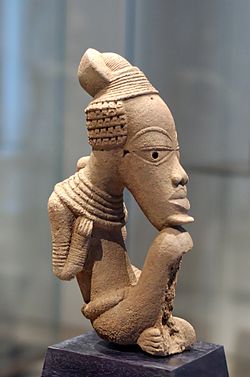
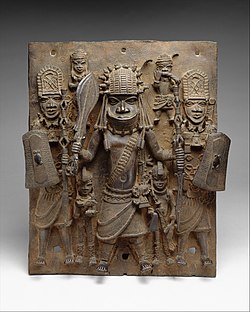
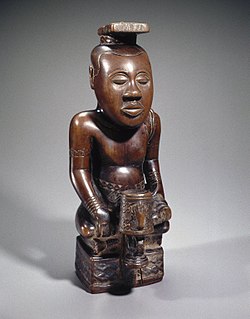

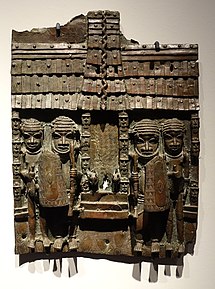
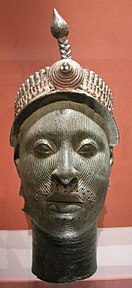






























![Mask for Obalufon II; circa 1300 AD; copper; height: 29.2 cm; discovered at Ife; Ife Museum of Antiquities (Ife, Nigeria)[53]](http://upload.wikimedia.org/wikipedia/commons/thumb/1/1d/Yoruba-bronze-head.jpg/132px-Yoruba-bronze-head.jpg)










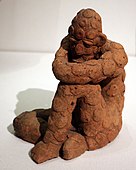


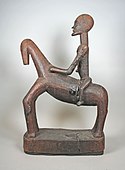






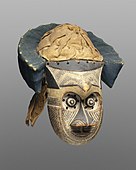




![Cloth; raffia; 20.3 x 85.7 cm (8 x 333⁄4 in.); Brooklyn Museum. In Kuba culture, men are responsible for raffia palm cultivation and the weaving of raffia cloth.[72] Several types of raffia cloth are produced for different purposes, the most common form of which is a plain woven cloth that is used as the foundation for decorated textile production.](http://upload.wikimedia.org/wikipedia/commons/thumb/4/4d/Brooklyn_Museum_26549_Raffia_Cloth.jpg/170px-Brooklyn_Museum_26549_Raffia_Cloth.jpg)
